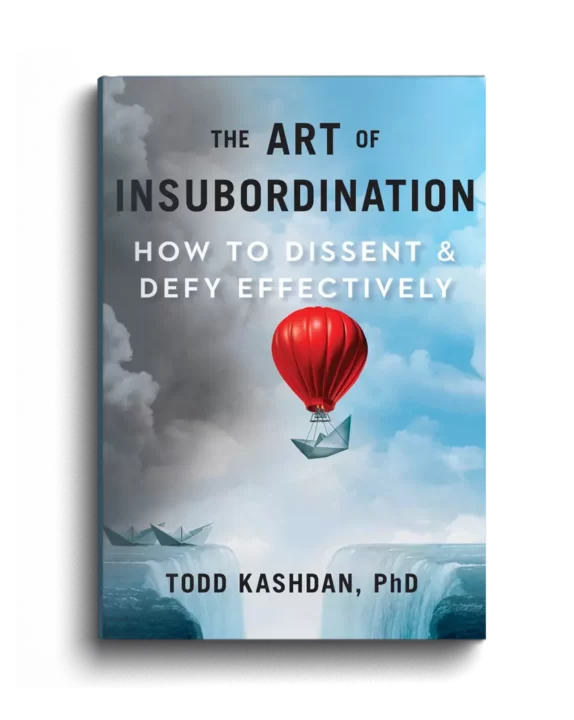Reading time: 10 minutes
— Researched and reviewed by Dr. Sandip Roy.Insubordination at work is often not a single act, but an entire attitude.
Every employer expects a certain level of work ethic because work gets done well only when employees follow a chain of command. Acts of insubordination break that chain and stop work from flowing smoothly.
Also, in today’s “Yes boss, we’ll do what you say (and take the blame if things go bad)!” work environment, even a single act of insubordination can cost you your job, or at least a promotion or fair appraisal.
Moreover, it appears there are some workers in every company who make a point of defying their bosses, consequences be doggoned. This willful refusal to follow instructions threatens the whole enterprise.
Overview:
- Insubordination is when an employee doesn’t follow directives or disrespects their supervisor.
- Reasons for insubordination can range from miscommunication to a lack of respect for authority.
- Insubordination must be addressed as soon as it rises, or it may turn into a prevalent toxic culture.
- Bosses must listen to employees’ perspectives and understand the root causes without prejudices.
- Clearly communicating expectations and consequences is necessary to prevent misunderstandings.
- The supervisor should stand up for themselves and maintain professionalism while dealing with it.
- Instances of insubordination may be documented to track patterns and for disciplinary actions.
- Additional training or coaching may be needed to help employees improve their performance.

Table of Contents
Curiosity is insubordination in its purest form. — Vladimir Nabokov
Defining Insubordination
Insubordination is a willful refusal to follow directions from a superior, senior, or boss. It means defying authority and disobeying orders, though it can also refer to rude and disrespectful behavior. It is also referred to as noncompliance, disobedience, defiance, and rebelliousness.
• A subordinate is a person of lower rank or authority who must obey and respect their superior.
• An insubordinate is an employee who refuses to obey or respect the person in charge of them.
Now, let’s pick up and answer the commonly asked questions on insubordination:
1. What is considered insubordination in the workplace?
At work, insubordination is the intentional refusal to comply with a superior’s legal and ethical order. Such an act can disrespect a supervisor, decrease their administrative authority, and eventually harm the organization’s efficiency. It usually calls for disciplinary action, including suspension and termination.
An act of insubordination is not always predictable. Some “moron” always manages to find a reason to challenge a superior and refuse to perform as told, even if that superior is reputed as a dictator in having his orders obeyed.
Disobeying orders is always severely penalized in the military. At other places of work, however, the reprisal is typically milder, if you can call being fired milder.
2. Can a single act of insubordination create a bigger issue?
Yes, a single act of insubordination can lead to serious issues like termination and arrest. A rebellion against a boss can quickly devolve into a culture of distrust and nonconfidence. So, even a single act of insubordination at work is rarely condoned or overlooked; instead, it typically paves the way to termination.
One act of disobedience can temporarily undermine a superior’s authority, but the more concerning issue is that it can permanently damage a company’s culture of compliance and collaboration.
Therefore, a lone act of insubordination may make the company take drastic measures like a demotion, termination, blocking of severance benefits, and even arrest by legal authorities of the employee.
Furthermore, there can be a justifiable drama on the flip side too.
The superior may be fired or asked to resign voluntarily to save face, shortly after the act of insubordination, especially if they are not in a very prominent position.
The termination of the superior typically occurs as a result of an inquiry revealing that they lacked the authority to get things done, were unrealistic in pushing their demands on the employee or had misrepresented the employee’s stand.
Such a superior should be fired along with the worker because one defiant conduct may motivate other staff to follow suit, and soon lead to a disruptive mutiny in the department.
In fact, if a supervisor appears to have little power over those beneath, and there is a repetitive pattern of insubordinate behavior, they should be fired first. Otherwise, the organization’s overall stability and structure are jeopardized.
Most of us have heard of narcissistic bosses who take evil pleasure in giving out mountains of work on weekends. While these bosses try to grab a posse of fans, they also acquire a band of disgruntled staff. These superiors-juniors have a very intriguing equation going on:
- From the superior’s viewpoint, even one act of insubordination breaks down the chain of command and disrupts the workflow. Therefore, it calls for strict disciplinary action, even if they had it hard to overlook their wounded ego.
- From the insubordinate’s side, their action may seem perfectly justified since they only disobeyed a superior’s “unjust” orders, or were simply trying to innovate, not pare down their boss’s ego.
There is also a compassionate aspect to this. We miss seeing the human emotions at work behind the human at work.
In modern workplaces, corporations are frequently structured like bureaucracies. There are a humongous number of rules and regulations to guide the organization.
While the big fat rule book is there for a reason, it can often lead to a lack of attention to the staff’s real needs, like expectations of being understood and shown empathy, and this can lead to insubordination.
3. Is one’s yelling at the boss insubordination?
In most situations, raising one’s voice at a superior is insubordination. An employee shouting at their boss indicates they want to silence them. Yelling also indicates that the employee refuses to recognize their superior’s leadership and does not respect the authority of their position.
A person of authority must deal with yelling like any other act of workplace insubordination. Neglecting to respond to it may result in the contagiousness of the act, and soon, other employees may do the same.
Eventually, it works to damage the company culture and the structure of the organizational chain of command.
Abusive language at the workplace may be considered insubordination, which can be grounds for termination. However, many agree that workers using a few expletives or swear words should get some leniency and be let off with a warning.
In the author’s opinion, employees should not be allowed to insult or use abusive language against one another on the job. Of course, the use of derogatory language toward a person’s identity, gender, or race, should incur strict disciplinary action.
Yelling may be a natural reaction to months of working in a psychologically dangerous office environment, enduring the mean-spirited directives from toxic people.
Psychological safety is an emerging concept in workplace innovation. It speaks for a work environment where people feel safe opening up and being unguarded so that every expression of vulnerability is met with compassion. We can learn to increase Psychological Safety and build happier workplaces.
Strangely, silence can also be accounted for as insubordination and can lead to disciplinary action by the administration, and result in discharge from duty or removal from office.
4. How do you prove insubordination?
To prove insubordination:
- The superior must establish that the employee carried out the act with full intention after being clearly and directly communicated by the superior.
- Moreover, they had fully understood the request or order adequately and disobeyed it with full awareness of the possible consequences.
However, the above may not be held at small enterprises, like startups. The work climate at these places is vastly informal and friendly. People there do not feel restricted by the hierarchy while relating to even the top-most-level bosses.
The workers at these small organizations often walk into their manager’s offices and talk to them directly, without the bureaucratic red tape. It makes for a dynamic interchange of ideas and encourages open feedback between managers and employees.
However, the drawback of the informal work environment is that it is hard to set boundaries and establish clear rules of insubordination.
5. Can you fire an employee for insubordination?
Some of the most obvious and legitimate cases where the insubordinate might be terminated from their job:
- Sexual harassment or sexual abuse
- Criminal acts as per the laws of the land
- Physical or emotional assault or persecution
- Demolishing office structures and equipment
- Repeated stonewalling (deliberate inaction)
Terminating the employee is often an extreme disciplinary action for insubordination. The firing of staff because of indiscipline or insubordination mostly depends on the seriousness and repetitiveness of the disobedience.
In some cases, the rank of employees vs. superiors played a factor; if the insubordinate employee was significantly lower in rank than the one they were insubordinate to, terminating the employee was more likely.
A staff insubordination issue is not worth the risk for legal practice, as it could cost the firm a lot of reputation and money. So, it is customary for a law firm to fire an insubordinate employee.
What are the most crucial questions on insubordination?
Some of the most pertinent issues around insubordination at work are:
• What is considered insubordination in the workplace?
• Can a single act of insubordination create a bigger issue?
• Is yelling at the boss considered insubordination?
• How do you prove insubordination?
• How do you discipline an employee for insubordination?
• Can you dismiss an employee for insubordination at work?
Read the 10 Unusually Effective Success Tips (No One Told You)
Final Words
Insubordination at work is noncompliance with a superior’s call to action. More than rebelliousness, it is defiance of authority.
But what if someone turns the established knowledge on its head? What if a leading expert on the psychology of well-being tells you otherwise?
Michael Douglas, as Gordon Gekko, said in the movie “Wall Street” —
Greed, for lack of a better word, is good. … Greed, in all of its forms; greed for life, for money, for love, for knowledge has marked the upward surge of mankind.
Somewhat similarly, Todd Kashdan, author of The Art of Insubordination, a brilliant book that intends to metamorphose the rebel in you, tells us —
It’s time to bring insubordination out of the darkness and infuse society with a healthy dose of nonconformity.
The book has been hailed by Charles Duhigg, the author of The Power of Habit, as “the book that all virtuous rebels need.”
Of the many things, the book will teach you:
- To embrace people who disagree openly and speak their minds.
- To create alliances that increase strength, knowledge, and wisdom.
- To cultivate curiosity, courage, and independent, critical thinking.
√ Please share it with someone if you found this helpful.
√ Also Read:
- Insubordination vs. Disobedience: How To Spot & Respond
- How To Address Insubordination In Remote Employees
- How To Handle Difficult People In Your Relationships
- How To Discipline Insubordination In An Employee
• Our Story!
